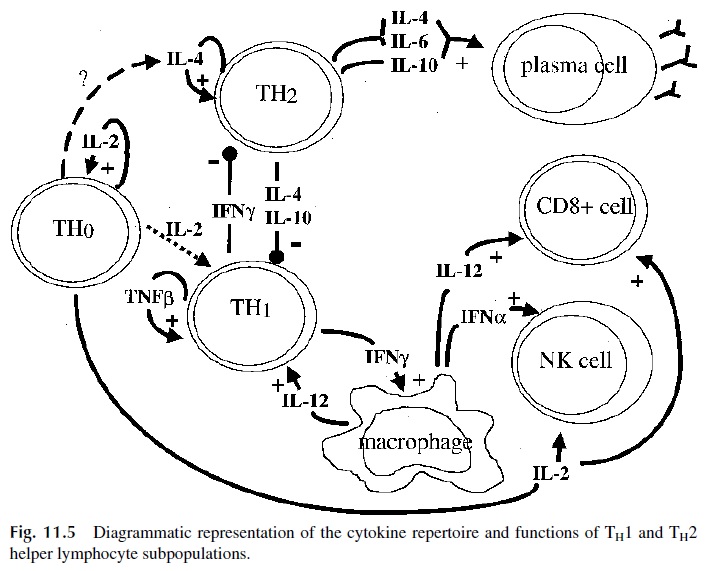Chapter: Medical Immunology: Cell-Mediated Immunity
T-Helper-Cell Subsets and their Regulatory Roles
T-HELPER-CELL SUBSETS AND THEIR REGULATORY ROLES
Studies in experimental animals (particularly in mice) suggest that the release of cytokines may obey specific patterns that determine the type of effect observed on target cells. Murine antigen–specific T-helper lymphocyte clones can be divided into three groups ac-cording to the type of cytokines they release after repetitive stimulation.
1. TH0 cells produce predominantly IL-2 and assist the initial proliferation of CD4+ cells.
2. TH1 cells also produce IL-2 but, in addition, produce IL-3, IFN-γ , and LT-α and assist the onset of delayed hypersensitivity, inflammatory, and cytotoxic reactions.
3. TH2 cells produce predominantly IL-4, IL-5, IL-6, and IL-10 and provide help to B lymphocytes.
An analogous subclassification of T-helper lymphocytes has been more difficult to es-tablish in humans, but recent work suggests that human antigen-specific CD4+ T-cell clones exhibit similar differences after long-term exposure to a stimulating antigen (Fig. 11.5).

There is considerable interest in understanding what factor(s) control TH1 and TH2 differentiation and activity . Interleukin 12, produced by antigen-presenting cells, seems to play an important role in the differentiation and activation of TH1 helper lymphocytes. The activated TH1 cells release IFN-γ which activates macrophages induc-ing additional release of IL-12 and a more efficient antimicrobial response, particularly against intracellular organisms. On the other hand, IL-4 appears to play a critical role in the differentiation and activation of TH 2 lymphocytes. The activation of TH 2 cells involves the activation of specific STAT transcription factors and is associated with lack of expression of the gene encoding the β chain of the IL-12 receptor. Thus, the IL-12R of TH2 cells lacks the β chain. The activation of TH1 cells involves a different set of STAT transcription fac-tors, and the gene encoding for the βchain of the IL-12R continues to be expressed. Thus, the IL-12Rβ chain is a marker of activated TH1 cells.
There is reciprocal counterregulation of the differentiation and activation of TH1 and TH 2 lymphocytes. Sustained production of high levels of IFN-γ suppresses IL-4 produc-tion, downregulating TH 2 activity. In contrast, during a strong TH2 response, high levels of IL-4 and IL-10 have inhibitory effects on cytokine release, affecting both IFN-γ and IL-12. As a consequence, the expansion of TH1 cells is downregulated.
Related Topics